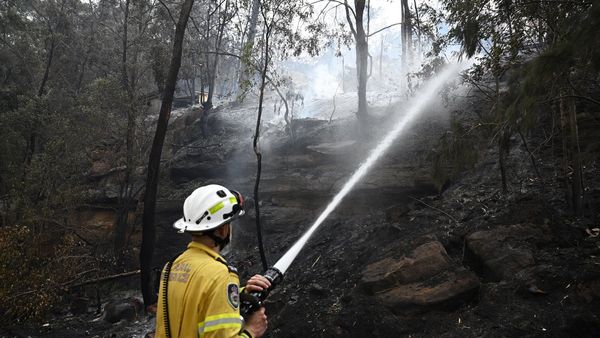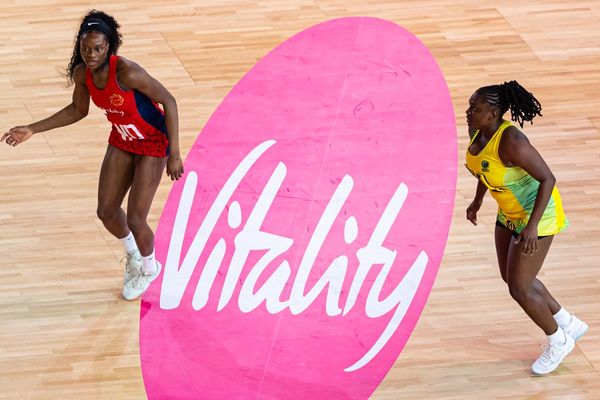
On Wednesday evening, in the first event of the 2022 Winter Olympics, Australians Tahli Gill and Dean Hewitt will make history. That is no mean feat. Representing a country with a proud Olympic record, there are few firsts left to be claimed in the green and gold uniform: Australia has competed at the Summer Games since federation and the Winter Games since 1936. But when the pair step out on to the ice for their opening encounter in the mixed doubles, they will become Australia’s first-ever Olympic curlers.
Hailing from a country without a single dedicated curling facility, Gill and Hewitt’s road to Beijing has not been easy. At the Games they will be up against the sport’s heavyweights. “I think given we’re not a typical curling nation, we are probably considered an underdog,” says Gill. “It’s a strong field, every single team there is really good. But that means that any team could come out on top.” Including, potentially, Australia. “For everyone at the Olympics, you want to try and get a medal – that would be fantastic,” adds Hewitt. “We’re just going to push as hard as we can every game and see what we can do out there.”
Curling was first played in Scotland in the early 16th century, with large, flat-bottomed rocks slid over frozen lakes. Today it typically takes place indoors on artificial ice-rinks and is popular in many cool-climate nations; Canada, Sweden, Switzerland, Norway and Great Britain dominate the sport competitively. “There is a lot involved: the precision, the power and endurance from sweeping as well,” says Hewitt. “And the strategy behind it is huge, the mental game is really important. It’s chess on ice, but we have to play really quickly – you’re on the clock.”
So how did two Australians, Gill from sunny Queensland and Hewitt from Victoria, end up competing in an icy sport, at the highest level?
Gill credits her mum. “She once saw curling at the Winter Olympics [on TV] and wanted to give it a go,” the 22-year-old says. “At the time I was figure-skating, so she was already in contact with the local ice rink.” When Gill’s mother was told the rink did not offer curling, she rounded up some Canadian and American expatriates and formed a curling club in Brisbane. “I saw her go training each night and ultimately represent Australia,” says Gill. “She really inspired me to give it a go – and now here I am.” It was a similar story for Hewitt, inspired by his Canadian mother, also a curling enthusiast. “I’ve been curling my whole life,” he says.

Growing up in the tight-knit domestic curling scene, Gill and Hewitt knew each other from junior competitions. But Hewitt, now 27, five years older than Gill, graduated to senior competition first. It was not until they met again at the national championships a few years ago that the possibility of competing together emerged.
“At the time Dean was playing with his mum, and I was playing with another partner,” says Gill. “Then Dean and his mum had a chat, and I got a call.” Hewitt stresses that it was a mutual decision, rebuffing a tongue-in-cheek interpretation that he dumped his mum for a new teammate. “She would have been over 60 for this Olympics, so we thought it was probably time to make a change and develop a team for the future,” he says.
The decision to curl together soon paid off, with the pair finishing fourth in a field of 48 nations at the 2019 world championships in Norway. It was the best finish for an Australian team in any curling discipline. Two years later, Gill and Hewitt needed a similar performance to qualify for Beijing, with the top seven teams automatically progressing to the Olympics. But despite a win over heavyweights Canada, the pair ultimately placed 13th.
This left Gill and Hewitt needing to finish in the top two at a last-gasp Olympic qualification event in the Netherlands in December, from a pool of 14 teams. A narrow one-point triumph over South Korea saw them secure their historic qualification spot. “It was very surreal,” Hewitt says.
The magnitude of their achievement for Australian curling is not lost on Gill and Hewitt. “We knew that if we got a team to the Olympics, it would grow the sport, because there’s always a lot of interest after an Olympic year,” says Gill. Hewitt adds: “I hope it does wonders for Australian curling.”

In an ideal world, increased interest would see the construction of a dedicated curling rink in Australia. “Hopefully that’s on the cards in the future,” Gill says. At present, clubs across the country train on multi-purpose hockey ice, used for ice hockey, figure skating and speed skating. “Those are the ice conditions we have to deal with, which are very different from when we’re overseas on dedicated curling ice,” she says. “But we make do with what we have and use the resources we’ve got in Australia.”
The absence of a standalone curling rink is not the only barrier to the growth of curling in Australia. Curling stones, which weigh 20kg and are sourced from only two granite quarries in the world, one in Scotland and one in Wales, do not come cheap, at about $500 a stone.
While some of Gill and Hewitt’s foreign rivals in Beijing curl professionally, the limited support for the sport in Australia means they both have other careers. Gill is studying to be a primary school teacher, while Hewitt is an exercise physiologist and works “a couple of odd jobs on the side”. After their 2019 world championships performance, the pair received some financial support from state institutes and the Olympic Winter Institute of Australia (which is underwritten by the Australian Institute of Sport). But compared to Summer Games sports, winter sports – and particularly curling – receive paltry funding.
Having overcome the lack of facilities and support to blaze an unlikely trail to the Winter Olympics, Gill and Hewitt offer a fairy-tale story. Already, other smaller curling nations are rallying behind the Australians. If the pair perform well at the Ice Cube in the coming days (the round-robin competition begins on Wednesday, with games played through to the gold medal match the following Tuesday), a cult following awaits.

Comparisons have been made to the Jamaican bobsleigh team’s 1988 Winter Olympics debut, which inspired the Disney movie Cool Runnings. “I think it has been mentioned that it’s kind of a Cool Runnings story, just because it’s so hot [in Australia], and curling is not very common,” says Gill. “That’s really cool.”
Gill’s preparations were momentarily derailed when she tested positive upon arrival in Beijing, only to be given the green light to compete after then returning two negative results, and while she and Hewitt know that they will make history when they step out on the ice on Wednesday, the pair hope to take it all in their stride.
“I think once you get out there, feel that ice underneath the slider and throw that first stone, I think once you actually get on the ice, it’ll feel like home,” says Hewitt. “It’s just when you look up, that’s the difference – when you see those Olympic rings.” For Australia, a proud sporting nation, it will be the first time Australians curlers have seen those Olympic rings. If Gill and Hewitt have their way, they will not be the last.







